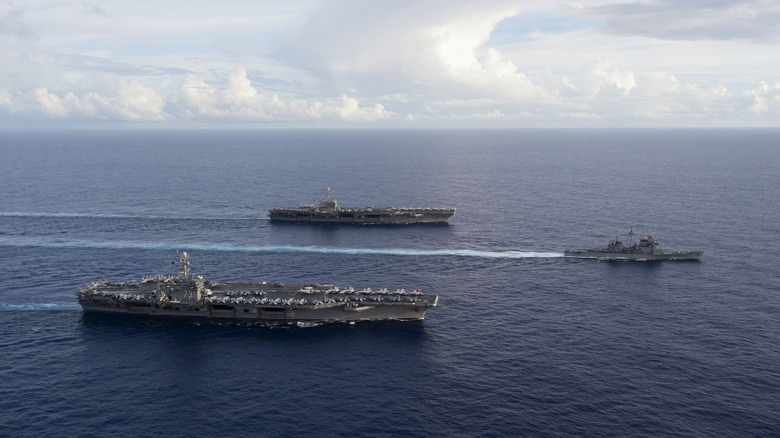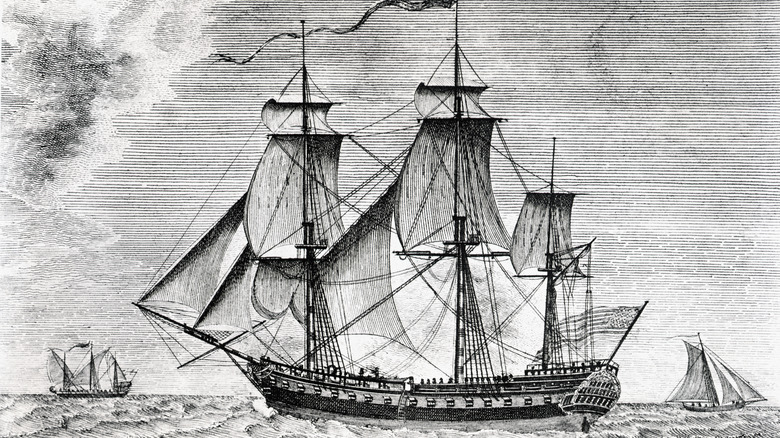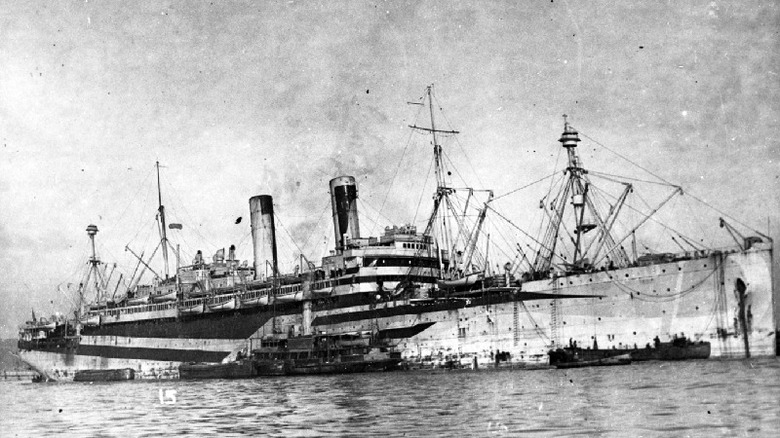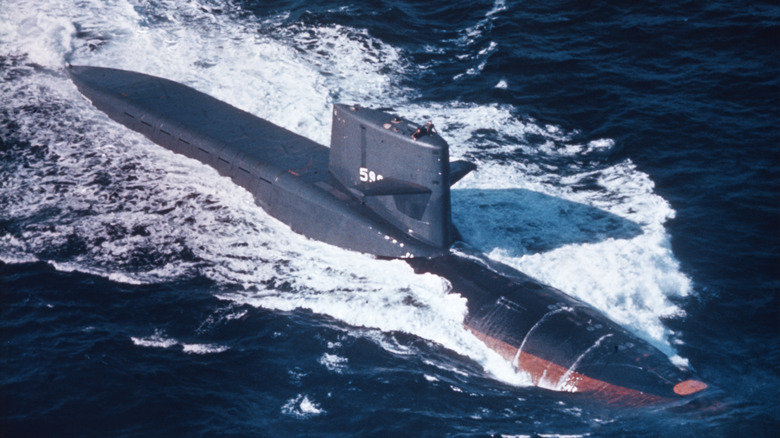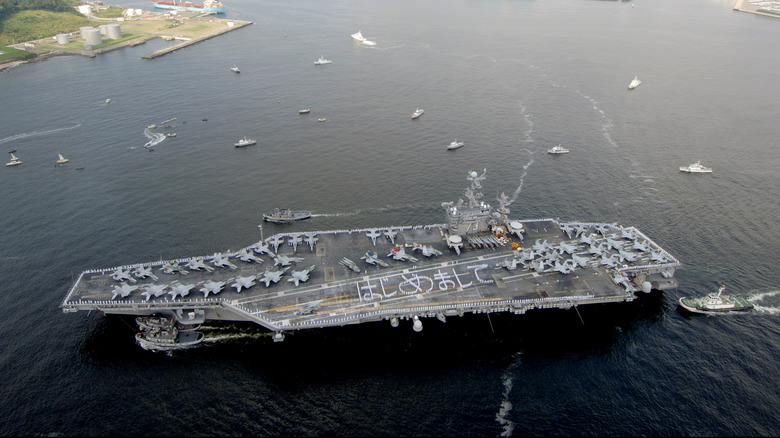How Many USS George Washington Aircraft Carriers Have There Been & Are Any In Service?
It's common practice for the United States Navy to reuse names for different ships. Just as there have been more than one USS Enterprise, there has been multiple USS George Washington's. The most suitable names for naval vessels are based on impactful, historical figures. Somebody like the Commander in Chief of the Continental Army and the first President of the United States is the perfect name for a representative of the United States of America.
Throughout the history of the United States Navy, there have been a total of four ships to bear the name George Washington. Of those four, there has only been one aircraft carrier, the George Washington (CVN-73), and it's still in use today. That's not to be confused with a slew of other ships simply named "Washington." If those ships were included, it would be a total of 10 ships.
The vessels named after George Washington have come in various shapes and classes, from an old 1800s frigate with cloth sails to a modern day aircraft carrier, launching fighter jets into combat zones. Here's a brief history lesson on the four USS George Washington ships.
USS George Washington I
The first George Washington started out as a merchant ship in 1793, just one of those large ships with sails like you saw in the "Pirates of the Caribbean" movies. However, the United States Congress bought it in October 1798 in preparation for war with the French. By December of the same year, the ship, and crew, sailed south to the West Indies to protect American shipping lanes. In 1800, the navy prepared the USS George Washington to travel across the Atlantic and became the first U.S. warship to sail to the Mediterranean Sea.
While in the Mediterranean, the George Washington was tasked with offering tribute to the Barbary pirates (Muslim pirates) who operated around North Africa. This was because the American Navy wasn't anywhere near as large as it is today. Captain William Bainbridge reluctantly sailed under an Algerian flag to bring gifts to the Sultan in Constantinople (modern day Istanbul).
Captain Bainbridge returned to America in April 1801 only to be returned to the Mediterranean in July of the same year with a skeleton crew. Shortly after the USS George Washington returned to America in April 1802, she was sold and no longer in use by the American Navy.
USS George Washington (ID-3018)
The second USS George Washington didn't start its tenure as a military vessel. The German company Vulcan Works designed and built the ship in Stettin, Germany as a passenger ship in 1908. The ship came to the United States in 1914, looking for safe harbor and by the time America entered the war in 1917, the U.S. government took control of it. It was brought to the New York Navy Yard in April 1917, converted into a troop transport ship for the navy, and commissioned in September 1917.
The most important guest who found passage aboard the ship was President Woodrow Wilson. In December 1918, President Wilson and other representatives from the U.S. sailed to Europe for the Paris Peace Conference. The King and Queen of Belgium also found the USS George Washington as their chariot when they came to New York City in 1919. Shortly after their visit, the vessel was decommissioned and given to the United States Shipping Board in 1920. By 1941, the U.S. Navy regained possession of the George Washington and recommissioned her as the USS Catlin.
Unfortunately, the coal-burning engines didn't produce a speed required to avoid enemy submarines and were decommissioned again. The ship remained in use by other agencies until 1947 when she was docked in Baltimore. It wasn't until a fire in 1951 forced her to be scrapped.
USS George Washington (SSBN-598)
The third naval vessel to bear the George Washington moniker was a ballistic submarine, commonly referred to as a boomer. It wasn't just any submarine, either. The USS George Washington SSBN-598, commissioned in December 1959, was the first ballistic missile submarine of its class as well as America's first nuclear-powered ballistic missile submarine. As one of the best Cold War era submarines, the USS George Washington was armed with 16 Polaris A1 missiles that had a range of 1,200 miles and could be armed with a nuclear warhead. With six 533-millimeter torpedo tubes in the bow for defense, the George Washington's very presence, was a deterrent against other nuclear-armed nations.
Before receiving her full complement of Polaris missiles, the George Washington performed a series of tests with two of them. The boomer made history with its first successful launch, being the first submerged submarine to launch a ballistic missile. The boomer's maiden voyage saw her remain submerged for 66 days before returning to port. SSBNs typically stay at sea for 77 days and remain in port for 35 days while maintenance is performed on the vessel.
After serving the United States for roughly 25 years, performing classified patrols throughout the Cold War, the navy decommissioned the USS George Washington SSBN-598 in January 1985. While the bulk of her was scrapped, the sail was donated to the Submarine Force Museum in Groton, Connecticut, where she was commissioned.
The only USS George Washington still in service
The only active USS George Washington today is the Nimitz-class aircraft carrier, hull designation CVN-73. This is the sixth Nimitz-class carrier, making it a ship that's 1,092 feet long, 252 feet wide, and has a 100,000 ton displacement. She was commissioned in 1992 but didn't set sail for her maiden deployment until May 20, 1994. The USS Washington aircraft carrier CVN-73 was the first American nuclear-powered carrier to be stationed in Japan when Yokosuka, Japan, became its homeport in 2008. It relieved the USS Kitty Hawk, which the navy decommissioned after 48 years of service.
USS George Washington remained in Japan until it was relieved by the USS Ronald Reagan (CVN-76) in 2015 so it could return to Virginia for a midlife refueling and maintenance. Before the Ronald Reagan relieved it, the 5,980 people aboard the USS George Washington assisted with humanitarian support during the Fukushima nuclear crisis in 2011. Then in 2014, USS George Washington traveled to Manila to support the government of the Philippines with disaster relief after Typhoon Yolanda devastated the country. Beyond humanitarian efforts, the carrier took part in Operation Enduring Freedom.
